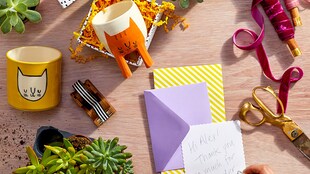The following is a transcript of a podcast episode released in October 2018. The transcript has been edited slightly for this format. You can listen to the episode on iTunes, SoundCloud, Spotify, or wherever you get your podcasts.
Taylor: Hi, I’m Taylor and I’m an editor on Etsy’s Seller Marketing team. I write many of the emails you receive from Etsy, and I also write education for Etsy’s Seller Handbook.
Isabella: And I’m Isabella, and I’m a shop optimisation specialist on the Community team here at Etsy. I work with the Search team to create education about search for sellers, like workshops, videos and articles.
Taylor: We recently published the Ultimate Guide to Etsy Search on the Seller Handbook. It’s an in-depth look at all the factors that go into search ranking, and it’s full of advice that you can use to brainstorm keywords for your titles and tags and optimise your shop for Etsy Search. Etsy Search is always changing, and the tips that we’re sharing today are based on our current best practices.
Isabella: So we hear a lot of questions about search within our Forums, support emails and within Team pages. We’ve pulled some of the top questions and concerns that we hear and we’re going to do a little bit of mythbusting.
Taylor: Are you ready?
Isabella: I’m ready! So the first one I want to bring up is about renewals. Taylor, can you mythbust this?: “Sellers should be renewing their listings every day to increase their visibility”.
Taylor: Before we dig into why this is a myth, I want to introduce a concept that we call listing quality score. This is a factor that goes into search ranking. We look at how shoppers interact with listings to gather clues about what’s popular with shoppers so that we can show you listings that you’re more likely to be excited about when you’re searching on Etsy. We look at how well a listing converts - basically how many people who click on it make a purchase - and that helps us create a quality score for that listing. And a high quality score can improve your search ranking.
One reason I think that this myth exists around renewing is that we do give listings a small, temporary boost in search when they’re newly created or renewed so that we can gather that information about how shoppers are interacting with the listing in search and give it a listing quality score. So it is true that they get a short, temporary boost, but I don’t think renewing your listings is a very effective strategy for improving your search ranking.
I think your time would be better spent really optimising your listings for conversion and helping give shoppers all the information they need to make a purchase decision. And also working on your keywords and your titles and tags so that you can potentially match with more searches.
So one thing that I hear is that shops are penalised for going into holiday mode or that the holiday mode can hurt your search ranking.
Isabella: Here’s the deal with the holiday mode. When you go on holiday mode, your listings are temporarily removed from search. While your listings are out of search, shoppers continue to conduct searches, shop for items, browse, click, purchase, favourite, Add to Basket - all those things. That continues to happen while your listings are temporarily out of search. It’s not that you’re being penalised, but other listings are gaining this engagement and these interactions.
And like you said earlier, listing quality, which comes from those conversions and those actions, contributes to search ranking. So yes, other listings may rank higher than you following you going on holiday. But over time, once you return, things should even out again. Going on holiday is a great way to take a small break. Just be aware that when you come back things won’t be as fast-moving as they were right when you left.
Isabella: The next myth that I’m going to bring up here is, “New shops get more priority in Etsy search than old shops”.
Taylor: Similar to the other things we were just talking about with holiday mode and listing quality score, when a new shop opens on Etsy, they create a listing, and we have no information about how shoppers are going to interact with that listing because it’s brand new to Etsy. We similarly give them a short boost and give that listing a chance to be seen so that we can understand how shoppers are interacting with it and give that listing a quality score. And it’s similar to the way that a new listing - like a listing that you’re creating for the very first time from a shop that’s been on Etsy for a long time - they would get a similar kind of boost. So that might be why when you’re searching you’re seeing some listings from brand new shops on Etsy.
Another myth we see is that sellers are concerned about the order that they input their tags and whether that order matters to their search ranking. Can you talk about that a little bit?
Isabella: This is a myth. The order of your tags does not matter. You can put them in any order you like. It’s not going to impact search ranking. It’s different with your title, which I think is where some of the confusion starts there. You do want to put your most searchable or your more important words in the front of your title for conversion purposes. When somebody’s on their mobile device or on their desktop and they’re browsing search results, they do typically see those first couple of words that you have in your title. In that case, maybe the order of your words is going to matter. But with tags, nope, it doesn’t matter.
Taylor: And just to be clear, it’s not that Etsy is giving any preference in search ranking to the order of the words in the title. But the words that are at the beginning of the title are the ones shoppers will see first so those can catch their attention.
Isabella: It can definitely influence conversions. The next one that we’ve been hearing about lately is, “Signing up for Etsy Plus improves your search ranking”.
Taylor: This is a myth, and we’ve been saying this since Etsy Plus launched this summer. Paying for a subscription has no effect on your search ranking. The only connection between Etsy Plus and Etsy Search is that when you subscribe to a subscription package you get $5 in Promoted Listings credits. Promoted Listings is an advertising tool that you can use to increase your visibility in search results, but you can also pay for Promoted Listings without signing up for a subscription package. I want to put this myth to rest because there’s no connection between paying for a subscription and your search ranking.
Isabella: The next myth here is, “Keywords have to be in both your titles and your tags to match with a query”.
Taylor: It’s a myth that the keyword has to appear in both your titles and tags in order for that listing to appear in the search results. But it is a good practice to use your strongest keywords in both those places, because when a keyword appears in your titles and tags and it matches the shopper’s query, that can increase the relevancy of that listing. It’s seen as very relevant to the shopper’s search, and that could improve that listing’s ranking in results for that search. But you don’t have to worry about putting all of your tags into your titles.
Instead we recommend that you write short, descriptive titles that are easy for a shopper to understand when they’re browsing all of the listings that are available to them in search results. Similar to what you were saying earlier with the order of the words in titles, a short, clear title will make it easy for a shopper to decide if they want to click on a listing. Something I know that you recommend is maybe three to four really descriptive phrases in the title.
Isabella: I think that’s the way to go. You may not end up using all 140 characters, but I definitely think coming up with three or four really strong, relevant phrases is a good way to rank in the most relevant searches as well as appeal from a conversions perspective.
Taylor: So this one is about categories. One thing that I think sellers are worried about is if they use really specific categories when they’re listing items, that that's narrowing the number of searches they might appear in. What can you tell me about this?
Isabella: I’ve heard this a lot too. This is a total myth. Adding specific categories doesn’t limit where your item is shown. It actually does the opposite and expands on the different areas that you can appear in. Not only do you appear in more category pages, but it’s also going to help with searches because each specific category that you’re adding - category, subcategory, all those that follow - these are going to act as tags on your listings. Those represent additional searches that you’ll be appearing in. For example, if you’re listing a mug, you want to list it in more than just Home & Living or Kitchen & Dining. You want to go all the way down to the Mugs category, and from there you’ll appear in Mugs, Drinkware, Drink & Barware, Kitchen & Dining, Home & Living.
Taylor: So it’s expanding your reach, not narrowing it.
Isabella: Yeah, you always want to go as far down as you can. The next one I’m going to bring up also relates to categories and subcategories. “You need to add the phrases in your categories and subcategories as tags.” Could you expand a little bit there?
Taylor: Like you said, categories act like tags so it’s a myth that you need to be repeating those phrases that appear in your categories in your tags. Etsy Search is scanning the keywords that are in your categories when matching your listings with a query. So adding those phrases in your tags is redundant and a missed opportunity to use those tags for other keyword-rich phrases that a shopper might use to find your item.
Isabella: Right, so to be blunt, you’re basically wasting a tag if you’re mimicking the category.
Taylor: Moving on to a different topic, photography is something that we hear about a lot. One myth that we hear is that listings with all 10 photos are going to be ranked higher by Etsy Search.
Isabella: We do hear this a lot. No, we don’t look at how many photos you’ve added to your listing and from there make any ranking decisions. But here’s the deal: We do still recommend using all 10 listing photos because the more listing photos you have, the more people are going to engage with your item. They’re going to click through all of those images and it’s either going to give them more confidence toward purchasing your item, or it’ll have them spending more time on your page and from there they might find another item that they like.
All of this activity that comes from 10 listing photos can contribute to the listing quality score that you were talking about earlier. Any positive conversion is going to help with your search ranking. Indirectly I’d say that it has an impact, but directly related to the search algorithm, no. There’s no correlation between photo count and search ranking.
Taylor: Yeah, it all ties back to that conversion and listing quality score. Using all 10 of your photos is an opportunity to answer your shopper’s questions so that they’re more confident clicking Add to Basket and purchasing that item.
Isabella: Think of it more as an opportunity to convert. So you could show it at all different angles. If it’s something people wear, you can show it modelled on a person. It’s also a great opportunity to show off packaging or branding.
Taylor: Now we’re going to move into some listing critiques. We put out a call in the Forums and asked you to submit your listings for a keyword critique. Isabella and I have looked at the titles and tags on these listings, and we’re going to share some tips on how you might create more opportunities to match with shopper searches using keywords.
Isabella: Thanks to everyone who submitted. We had a really great time looking through all of your listings. The first item I have here is a really beautiful piece of wall decor from Scenic Shore Creations. It’s got a fish put together out of cut wood pieces. It has a nautical vibe to it, and it looks like something you’d hang up in your beach house - really cute. The first thing I’m noticing as I’m looking at this listing is that the seller isn’t using all 13 tags. And as we talked about before it’s so important to take advantage of these opportunities.
If you’re trying to improve your visibility, if you’re trying to appear in more searches, not using all of the tag slots available to you could prevent you from doing that. I would encourage the seller to add more tags to her listing and to really take these tags to the next level as well. Right now, the current tags I’m seeing that could be worked on a little bit are “fish art”, “fishing”, “beach art”. While these are all relevant, they’re not very specific. By taking them to the next level, making them maybe from words into phrases or just more specific phrases, you’re going to put yourself in front of what I like to call the "right buyers". Those are the people who are already on the hunt for something like this. They want a piece of art like this. They have it in mind, and that’s what they’re shopping for.
As you’re working on your tags, things to think about are materials, where you might hang something like this, who it’s for if it’s a gift, or if it’s just something that you would want in your own home. And then my last piece of advice would be for the title, maybe make that first phrase a little more descriptive. Again, we talked about this earlier. It’s not that it will impact ranking directly, but there could be an indirect impact in that that first phrase is usually what people see when browsing and when shopping search results. Having something a little more descriptive there or specific to the item I think could help.
Taylor: I love this. It’s very nautical. My first listing is a gold bangle bracelet that has a keychain attached to it. And it has some really cute decorative charms and tassels, and this is from the shop Jill Makes. And she’s using a lot of great tags with the word “keychain” since that’s what the target customer might be searching for. But I think a missed opportunity for her tags is that in reading the description and looking at the pictures, I see that this item can be personalised with an initial charm. Shoppers who are coming to Etsy looking for a personalised gift might search something like “monogram keychain” or “personalised key ring”. That’s a new market that you might reach by adding some of those tags: People who are really looking for that special touch on their item.
She’s also using the tags “tassel keychain” and “colourful keychain” because there are these cool decorations on the bracelet. One thing you can think about when you’re adding keywords is, what is the style of someone who might love this item and what kinds of words might they use to search? Something like “eclectic keychain” could be fun here.
Another thing that’s really cool about this listing - it’s something I haven’t really seen before - is that it’s a bangle bracelet and a keychain. It’s glamourous and practical at the same time. She’s using the tag “bangle” but it’s not a compound phrase, so it’s not really working as hard for her as it could be. Something like “gold bangle keychain” or even “wearable keychain” that gets at this practical aspect of what someone might be looking for on Etsy. And then they would be delighted to find this really chic version of a wearable keychain.
Isabella: My next listing is a light-up wreath from The Wonky Fox. It looks like it’s made from some natural materials, and there’s greenery wrapped around it, and then there’s this little sleeping fox made from wool at the bottom. It’s really adorable. In terms of improvement, the first thing I’m seeing here is that they’re leading with short phrases like “woodland wreath”, “fox wreath”, and “woodland decor”. These are a bit vague, so think about taking it a step further. Focusing more on what makes this item unique would be helpful. Think about where this would go or what the purpose is.
Focusing on the night-light aspect of it makes it really special - so maybe “fox night-light” or “night-light wreath”. Leading with those words and turning the more simple tags into phrases like this could be really helpful. And again, just avoid single-word tags. I see the seller is avoiding it mostly, but there are a few that stood out that are single words, like “fox”.
Think about taking it a step further so you can better match with what a potential buyer is going to search. We don’t really see buyers just typing in one word when searching. And you can better match with someone’s search if you add more words there. Another tip I have is talking more about the greenery involved here. For instance, it looks like you’re using English ivy. I could be wrong on that. Taylor, does this look like English ivy?
Taylor: It looks like ivy to me.
Isabella: I think maybe adding in exactly what the greenery is could be helpful, especially for someone who’s shopping for a woodland-themed item. Also English ivy is trending right now, so it could be worth adding in.
Taylor: The next listing I have is a brown felt bear Christmas ornament, and he has a little customisable note that the seller personalises and attaches to the ornament, and this is from the shop MiKa Art. They’re using lots of descriptive tags that are really around this being a Christmas ornament, like “customised ornament” and “bear ornament”. I'd recommend thinking about what kind of personal style a shopper might have who is searching for an item like this, and how they might think about this bear ornament.
One thing you might consider adding would be "woodland ornament" or something that describes the aesthetic that this bear ornament might fit into. Something else I think is worth considering is Christmas decorators often have a vibe they’re going for with their Christmas decor, and they might be really into the fuzzy, felt texture of this bear ornament. Something like “felt bear ornament” or even just “felt ornament” could help people who are looking for that style of ornament to add to their collection.
Something else I was thinking about in terms of use is expanding your mind a little bit in how someone might use this bear ornament. The seller is customising it by adding this cute tag to the bear that you can personalise with your own message. Something like “custom gift tag” could be fun, and you could tie this little bear and your personalised message onto a wrapped gift. Think about how might someone use this item and what words would they search for to find something similar.
Isabella: My next listing comes from C.Banning Accessories. It’s a large red bag with a face pattern printed on it. It looks functional, has lots of pockets, good-sized handles, and it's artsy so I think I need this. For improvements, there are some really strong keywords here already. But I think doing some rearranging, ensuring we’ve got the most important phrases toward the front for conversion purposes, and then in the best sequence for keyword matching purposes. For example, I would focus more on the face aspect of this bag, the fact that it’s functional, and then the fact that it’s red.
Maybe phrases like “red cross-body tote” and “large linen tote with pockets” and “abstract face pattern” or “face motif” would all work well in the title. For the tags, I’d avoid the more general phrases. Like here I see “clothing gift” and “best friend bag”. I’d go with something a little more specific to the product. Again I’m bringing up the pockets because I think that’s important and maybe a missed opportunity here. So “interior pockets” and then maybe the material also, so “linen canvas bag”. I think these would be strong keywords that would help somebody who’s got a more narrow, targeted search in mind find this product. Also the fact that it’s a rouge-red bag - that phrase would probably work better in the tags rather than the title.
Taylor: My last listing is also staying on this seasonal theme, and it’s an adorably spooky ghost that you can hang on your front door from Colette of the shop Ever Blooming Original. Her shop is full of really beautiful wreaths, and she’s using a lot of tags with the phrase “wreath”. But an opportunity for this item, because it’s more of a ghost that you hang on your door than it is a ghost wreath, would be something like “front door decor”. That’s a phrase I might recommend that she add to her tags.
It has this fun, childish, feminine vibe happening, and the ghosts have little bows on their heads. Something to think about would be: Where might someone hang this other than their front door? And who might be interested in this item? Something like “fall classroom decor” for teachers who are looking for something cute to add a festive touch to their classroom. The style is really charming, and I think she could emphasize that in the tags that she’s using. In addition to thinking about where it might hang, I think “cute ghost decor” would also be a good keyword for this item. And I noticed in some of her reviews for this product people were referring to it as cute. So you know that shoppers are already using that word to describe this item, and other people who are searching for cute ghosts might search a phrase like that.
Isabella: My last listing comes from Kentucky Stick Chairs, and it’s a foldable, wood, Adirondack-style chair. It’s really cool. There are already some solid phrases here in the mix, but there are also general phrases being used that probably aren’t going to bring this item much traffic. For example, “outdoor furniture” and “recessed hardware” are both in the title. I’m just not too sure that these are relevant or as relevant as other phrases might be. In the tags I also see things like “folk art” and “furniture and camping”. And these are just a little too vague.
I’m pretty sure that someone who’s shopping for a chair like this is probably going to lead with that in their searches, so I’d focus more on what the item is and what makes it different from the other Adirondack chairs it’s competing against in search. Maybe talk about how functional it is and the fact that this is foldable, that it’s easy to transport or store. I think these are all selling points that a buyer might have in mind when searching. Additionally, the material is important, so playing up the fact that it’s yellow pine and that it’s handcrafted could be really helpful.
One thing I noticed about this listing specifically is that the seller has written out a long and beautiful description. If you get stuck on where to go with keywords, definitely read over your description because there’s a lot there that I think could go in the titles or tags to help rank higher in those most relevant searches.
Okay, thanks so much to everyone who submitted a listing. And if we didn’t get to yours there will be more listing critique opportunities in the Forums in the future.
 Words by Etsy Staff
Words by Etsy Staff




